Shale Gas Exploration and Development Potential Analysis of Lower Cambrian Niutitang Formation and Lower Silurian Longmaxi Formation in Northwestern Hunan, South China, Based on Organic Matter Pore Evolution Characteristics
Abstract
:1. Introduction
2. Geological Setting
2.1. The Longmaxi Shale
2.2. The Niutitang Shale
3. Data and Methods
3.1. Total Organic Carbon Content (TOC) Test
3.2. Vitrinite Reflectance (Ro) Test
3.3. X-ray Diffraction
3.4. Focused Ion-Beam Scanning Electron Microscopy (FIB-SEM)
3.5. N2 Adsorption and Mercury Intrusion Porosimetry (MIP)
3.6. Organic Matter Isolation
4. Results
4.1. Geological Characteristics of Shales Reservoir
4.1.1. TOC Contents of the Two Shales
4.1.2. Thermal Maturities of the Two Shales
4.1.3. Mineral Components of the Two Shales
4.2. OM Pore Properties of the Longmaxi Shale
4.3. OM Pore Properties of the Niutitang Shale
5. Discussion
5.1. Comparison of the Longmaxi and Niutitang Shales’ OM Pore Structures
- (1)
- According to electron microscopy, the number of OM pores in the Longmaxi shale is significantly higher than that in the Niutitang shale. The Niutitang shale also contains scattered pyrobitumen that lacks OM pores.
- (2)
- The shallow OM pores of the Niutitang shale make it unsuitable for adsorption and preservation because gas can quickly escape.
- (3)
- The OM pore shape of the Longmaxi shale is very regular, being mostly round and oval, while the OM pore shape of the Niutitang shale is irregular, being flat with a thin middle and thick and elongated ends, which is not favorable for gas adsorption and preservation.
5.2. Tectonic Evolution on OM Pore Structure
- (1)
- If the strata subside quickly and are deep buried, the hydrocarbon-generation evolution of shale will intensify and the OM pore generation will increase accordingly. Oppositely, if the strata undergo substantial uplift during the regional tectonic evolution, the hydrocarbon-generation evolution of shale will weaken and the OM pore generation will decrease accordingly.
- (2)
- If the hydrocarbon-generation evolution of shale strata lasts for a long time, the organic matter can be fully evolved, which will generate a sufficient number of OM pores with large diameter and such OM pore structure is conducive to the gas occurrence. Oppositely, if the hydrocarbon-generation evolution of shale strata lasts for a short time, the organic matter cannot be fully evolved, which will result in poor OM structure, a forming limited number of OM pores with a small diameter.
5.2.1. Hydrocarbon-Generation Evolution Process
5.2.2. Hydrocarbon-Generation Evolution Degree
5.3. Shale Gas Exploration Potential Analysis
6. Conclusions
- (1)
- The Lower Cambrian Niutitang shale and the Lower Silurian Longmaxi shale both exhibit high TOC concentration and high brittle mineral content, which are similar reservoir features. The thermal maturity of the Longmaxi shale, however, is much lower than that of the Niutitang shale, the latter having a thermal maturity of greater than 3.0% while the former ranges from 2.3% to 3.0%.
- (2)
- The Lower Cambrian Niutitang shale and the Lower Silurian Longmaxi shale have substantially different organic matter pore structures. The Niutitang shale features few irregularly sized organic matter pores that mostly have an extended flat appearance, making it undesirable for gas occurrence.
- (3)
- The thermal maturity of shale reservoirs, which in turn impacts the variability of organic matter pore structure, can be affected by the maximum paleo-burial depth of the strata governed by tectonic evolution. As with the Niutitang shale in our study, excessive shale development and the degradation of organic matter pore structure will result if the maximum paleo-burial depth reaches 8000 m or higher.
- (4)
- The Longmaxi Formation shale in northwest Hunan failed to develop enough gaseous hydrocarbons and a significant quantity of effective reservoir space (OM pores with big pore size) as a result of insufficient hydrocarbon-generation evolution time. The Lower Silurian Longmaxi Formation and the Lower Cambrian Niutitang Formation in northwest Hunan have limited exploration and development potential for marine shale gas.
Author Contributions
Funding
Institutional Review Board Statement
Informed Consent Statement
Data Availability Statement
Conflicts of Interest
References
- Meng, M.; Peng, J.; Ge, H.; Ji, W.; Li, X.; Wang, Q. Rock fabric of lacustrine shale and its influence on residual oil distribution in the Upper Cretaceous Qingshankou Formation, Songliao Basin. Energy Fuels 2023, 37, 7151–7160. [Google Scholar] [CrossRef]
- Meng, M.; Ge, H.; Shen, Y.; Ji, W.; Li, Z. Insight into water occurrence and pore size distribution by nuclear magnetic resonance in marine shale reservoirs, southern China. Energy Fuels 2023, 37, 319–327. [Google Scholar] [CrossRef]
- Chen, Q.; Kang, Y.; You, L.; Yang, P.; Zhang, X.; Cheng, Q. Change in composition and pore structure of Longmaxi black shale during oxidative dissolution. Int. J. Coal Geol. 2017, 172, 95–111. [Google Scholar] [CrossRef]
- Gou, Q.; Xu, S.; Hao, F.; Yang, F.; Zhang, B.; Shu, Z.; Zhang, A.; Wang, Y. Full-scale pores and micro-fractures characterization using FE-SEM, gas adsorption, nano-CT and micro-CT: A case study of the Silurian Longmaxi Formation shale in the Fuling area, Sichuan Basin, China. Fuel 2019, 253, 167–179. [Google Scholar] [CrossRef]
- Guo, X.; Hu, D.; Li, Y.; Wei, Z.; Wei, X.; Liu, Z. Geological factors controlling shale gas enrichment and high production in Fuling shale gas field. Pet. Explor. Dev. 2017, 44, 513–523. [Google Scholar] [CrossRef]
- He, Z.; Li, S.; Nie, H.; Yuan, Y.; Wang, H. The shale gas “sweet window”: “The cracked and unbroken” state of shale and its depth range. Mar. Pet. Geol. 2018, 101, 334–342. [Google Scholar] [CrossRef]
- He, Z.; Nie, H.; Li, S.; Luo, J.; Wang, H.; Zhang, G. Differential enrichment of shale gas in upper Ordovician and lower Silurian controlled by the plate tectonics of the Middle-Upper Yangtze, south China. Mar. Pet. Geol. 2020, 118, 104357. [Google Scholar] [CrossRef]
- Yang, W.; He, S.; Iglauer, S.; Guo, X.; Zhai, G.; Zhou, Z.; Dong, T.; Tao, Z.; Wei, S. Porosity characteristics of different lithofacies in marine shale: A case study of Neoproterozoic Sinian Doushantuo formation in Yichang area, China. J. Pet. Sci. Eng. 2020, 187, 106856. [Google Scholar] [CrossRef]
- Wang, P.; Yao, S.; Jin, C.; Li, X.; Zhang, K.; Liu, G.; Zang, X.; Liu, S.; Jiang, Z. Key reservoir parameter for effective exploration and development of high-over matured marine shales: A case study from the cambrian Niutitang formation and the silurian Longmaxi formation, south China. Mar. Pet. Geol. 2020, 121, 104619. [Google Scholar] [CrossRef]
- Hu, H.; Hao, F.; Lin, J.; Lu, Y.; Ma, Y.; Li, Q. Organic matter-hosted pore system in the Wufeng-Longmaxi (O3w−S11) shale, Jiaoshiba area, Eastern Sichuan Basin, China. Int. J. Coal Geol. 2017, 173, 40–50. [Google Scholar] [CrossRef]
- Hou, Y.; Zhang, K.; Wang, F.; He, S.; Dong, T.; Wang, C.; Qin, W.; Xiao, Y.; Tang, B.; Yu, R.; et al. Structural evolution of organic matter and implications for graphitization in over-mature marine shales, south China. Mar. Pet. Geol. 2019, 109, 304–316. [Google Scholar] [CrossRef]
- Zhao, J.; Jin, Z.; Hu, Q.; Liu, K.; Liu, G.; Gao, B.; Liu, Z.; Zhang, Y.; Wang, R. Geological controls on the accumulation of shale gas: A case study of the early Cambrian shale in the Upper Yangtze area. Mar. Pet. Geol. 2019, 107, 423–437. [Google Scholar] [CrossRef]
- Jiao, K.; Yao, S.; Liu, C.; Gao, Y.; Wu, H.; Li, M.; Tang, Z. The characterization and quantitative analysis of nanopores in unconventional gas reservoirs utilizing FESEM–FIB and image processing: An example from the lower Silurian Longmaxi Shale, upper Yangtze region, China. Int. J. Coal Geol. 2014, 128, 1–11. [Google Scholar] [CrossRef]
- Ji, W.; Song, Y.; Jiang, Z.; Chen, L.; Li, Z.; Yang, X.; Meng, M. Estimation of marine shale methane adsorption capacity based on experimental investigations of Lower Silurian Longmaxi formation in the Upper Yangtze Platform, south China. Mar. Pet. Geol. 2015, 68, 94–106. [Google Scholar] [CrossRef]
- Ji, W.; Song, Y.; Rui, Z.; Meng, M.; Huang, H. Pore characterization of isolated organic matter from high matured gas shale reservoir. Int. J. Coal Geol. 2017, 174, 31–40. [Google Scholar] [CrossRef]
- Meng, M.; Ge, H.; Shen, Y.; Ji, W.; Wang, Q. Rock fabric of tight sandstone and its influence on irreducible water saturation in Eastern Ordos Basin. Energy Fuels 2023, 37, 3685–3696. [Google Scholar] [CrossRef]
- Lan, Z.; Li, X.; Chu, X.; Tang, G.; Yang, S.; Yang, H.; Liu, H.; Jiang, T.; Wang, T. SIMS U-Pb zircon ages and Ni-Mo-PGE geochemistry of the lower Cambrian Niutitang Formation in South China: Constraints on Ni-Mo-PGE mineralization and stratigraphic correlations. J. Asian Earth Sci. 2017, 137, 141–162. [Google Scholar] [CrossRef]
- Jin, Z.; Nie, H.; Liu, Q.; Zhao, J.; Jiang, T. Source and seal coupling mechanism for shale gas enrichment in upper Ordovician Wufeng Formation—Lower Silurian Longmaxi Formation in Sichuan Basin and its periphery. Mar. Pet. Geol. 2018, 97, 78–93. [Google Scholar] [CrossRef]
- Qin, M.; Guo, J.; He, H.; Huang, Y.; Jiao, P.; Liu, C.; Zheng, Z.; Guo, J.; Cao, Z.; Wang, C.; et al. Geological conditions and gas-bearing characteristics of shale gas in complex structure area out of Sichuan basin: A case of Wufeng—Longmaxi formation in Northwestern Hunan, China. J. Central South Univ. (Sci. Tech.) 2018, 49, 1979–1990. [Google Scholar]
- Liu, A.; Ou, W.; Huang, H.; Wei, K.; Li, H.; Chen, X. Significance of paleo-fluid in the Ordovician–Silurian detachment zone to the preservation of shale gas in western Hunan–Hubei area. Nat. Gas Ind. B 2018, 5, 565–574. [Google Scholar] [CrossRef]
- Li, F.; Wang, M.; Liu, S.; Hao, Y. Pore characteristics and influencing factors of different types of shales. Mar. Pet. Geol. 2019, 102, 391–401. [Google Scholar] [CrossRef]
- Liu, G.; Zhai, G.; Zou, C.; Cheng, L.; Guo, X.; Xia, X.; Shi, D.; Yang, Y. A comparative discussion of the evidence for biogenic silica in Wufeng-Longmaxi siliceous shale reservoir in the Sichuan basin, China. Mar. Pet. Geol. 2019, 109, 70–87. [Google Scholar] [CrossRef]
- Liu, Z.; Gao, B.; Zhang, Y.; Du, W.; Feng, D.; Nie, H. Types and distribution of the shale sedimentary facies of the Lower Cambrian in Upper Yangtze area, South China. Pet. Explor. Dev. 2017, 44, 20–31. [Google Scholar] [CrossRef]
- Nie, H.; Sun, C.; Liu, G.; Du, W.; He, Z. Dissolution pore types of the wufeng formation and the longmaxi formation in the sichuan basin, south china: Implications for shale gas enrichment. Mar. Pet. Geol. 2019, 101, 243–251. [Google Scholar] [CrossRef]
- Hassan, M.; Leila, M.; Ahmed, M.; Issa, G.; Hegab, O. Geochemical characteristics of natural gases and source rocks in Obayied sub-basin, north Western Desert, Egypt: Implications for gas-source correlation. Acta Geochim. 2023, 42, 241–255. [Google Scholar] [CrossRef]
- Leila, M.; Loiseau, K.; Moretti, I. Controls on generation and accumulation of blended gases (CH4/H2/He) in the Neoproterozoic Amadeus Basin, Australia. Mar. Pet. Geol. 2022, 140, 105643. [Google Scholar] [CrossRef]
- Xu, Z.; Wang, Y.; Jiang, S.; Fang, C.; Liu, L.; Wu, K.; Luo, Q.; Li, X.; Chen, Y. Impact of input, preservation and dilution on organic matter enrichment in lacustrine rift basin: A case study of lacustrine shale in Dehui Depression of Songliao Basin, NE China. Mar. Pet. Geol. 2022, 135, 105386. [Google Scholar] [CrossRef]
- Wang, Q.; Wang, T.; Liu, W.; Zhang, J.; Feng, Q.; Lu, H.; Peng, P. Relationships among composition, porosity and permeability of Longmaxi Shale reservoir in the Weiyuan Block, Sichuan Basin, China. Mar. Pet. Geol. 2019, 102, 33–47. [Google Scholar] [CrossRef]
- Wu, J.; Zhang, S.; Cao, H.; Sun, P.; Luo, X. Fracability evaluation of shale gas reservoir-A case study in the Lower Cambrian Niutitang formation, northwestern Hunan, China. J. Pet. Sci. Eng. 2017, 164, 675–684. [Google Scholar] [CrossRef]
- Xi, Z.; Tang, S.; Wang, J. The reservoir characterization and shale gas potential of the Niutitang formation: Case study of the SY well in northwest Hunan area, South China. J. Pet. Sci. Eng. 2018, 171, 687–703. [Google Scholar] [CrossRef]
- Zhou, L.; Kang, Z.; Wang, Z.; Peng, Y.; Xiao, H. Sedimentary geochemical investigation for paleoenvironment of the Lower Cambrian Niutitang Formation shales in the Yangtze Platform. J. Pet. Sci. Eng. 2017, 159, 376–386. [Google Scholar] [CrossRef]
- Yang, X.; Fan, T.; Wu, Y. Lithofacies and cyclicity of the lower cambrian niutitang shale in the mayang basin of western hunan, south china. J. Nat. Gas Sci. Eng. 2016, 28, 74–86. [Google Scholar] [CrossRef]
- Zhang, Q.; Littke, R.; Zieger, L.; Shabani, M.; Tang, X.; Zhang, J. Ediacaran, Cambrian, Ordovician, Silurian and Permian shales of the Upper Yangtze Platform, South China: Deposition, thermal maturity and shale gas potential. Int. J. Coal Geol. 2019, 216, 103281. [Google Scholar] [CrossRef]
- Wang, P.; Jiang, Z.; Chen, L.; Yin, L.; Li, Z.; Zhang, C.; Wang, G. Pore structure characterization for the Longmaxi and Niutitang shales in the Upper Yangtze Platform, South China: Evidence from focused ion beam–He ion microscopy, nano-computerized tomography and gas adsorption analysis. Mar. Pet. Geol. 2016, 77, 1323–1337. [Google Scholar] [CrossRef]
- Wang, P.; Jiang, Z.; Ji, W.; Zhang, C.; Yuan, Y.; Chen, L.; Yin, L. Heterogeneity of intergranular, intraparticle and organic pores in Longmaxi shale in Sichuan Basin, South China: Evidence from SEM digital images and fractal and multifractal geometries. Mar. Pet. Geol. 2016, 72, 122–138. [Google Scholar] [CrossRef]
- Wang, Y.; Wang, L.; Wang, J.; Jiang, Z.; Jin, C.; Wang, Y. Characterization of organic matter pores in typical marine and terrestrial shales, China. J. Nat. Gas Sci. Eng. 2018, 49, 56–65. [Google Scholar] [CrossRef]
- Xu, H.; Zhou, W.; Zhang, R.; Liu, S.; Zhou, Q. Characterizations of pore, mineral and petrographic properties of marine shale using multiple techniques and their implications on gas storage capability for Sichuan Longmaxi gas shale field in China. Fuel 2019, 241, 360–371. [Google Scholar] [CrossRef]
- Xu, S.; Liu, R.; Hao, F.; Engelder, T.; Yi, J.; Zhang, B.; Shu, Z. Complex rotation of maximum horizontal stress in the Wufeng-Longmaxi Shale on the eastern margin of the Sichuan Basin, China: Implications for predicting natural fractures. Mar. Pet. Geol. 2019, 109, 519–529. [Google Scholar] [CrossRef]
- Xu, S.; Gou, Q.; Hao, F.; Zhang, B.; Shu, Z.; Lu, Y.; Wang, Y. Shale pore structure characteristics of the high and low productivity wells, Jiaoshiba shale gas field, Sichuan Basin, China: Dominated by lithofacies or preservation condition? Mar. Pet. Geol. 2020, 114, 104211. [Google Scholar] [CrossRef]
- Yang, R.; Hao, F.; He, S.; He, C.; Guo, X.; Yi, J.; Hu, H.; Zhang, S.; Hu, Q. Experimental investigations on the geometry and connectivity of pore space in organic-rich Wufeng and Longmaxi shales. Mar. Pet. Geol. 2017, 84, 225–242. [Google Scholar] [CrossRef]
- Zhao, J.; Jin, Z.; Jin, Z.; Hu, Q.; Hu, Z.; Du, W.; Yan, C.; Geng, Y. Mineral types and organic matters of the Ordovician-Silurian Wufeng and Longmaxi Shale in the Sichuan Basin, China: Implications for pore systems, diagenetic pathways, and reservoir quality in fine-grained sedimentary rocks. Mar. Pet. Geol. 2017, 86, 655–674. [Google Scholar] [CrossRef]
- Xi, Z.; Tang, S.; Zhang, S.; Yi, Y.; Dang, F.; Ye, Y. Characterization of quartz in the Wufeng Formation in northwest Hunan area, south China and its implications for reservoir quality. J. Pet. Sci. Eng. 2019, 179, 979–996. [Google Scholar] [CrossRef]
- Jacob, H. Classification, structure, genesis and practical importance of natural solid oil bitumen (“migrabitumen”). Int. J. Coal Geol. 1989, 11, 65–79. [Google Scholar] [CrossRef]
- Loucks, R.G.; Reed, R.M.; Ruppel, S.C.; Jarvie, D.M. Morphology, genesis, and distribution of nanometer-scale pores in siliceous mudstones of the Mississippian Barnett Shale. J. Sediment. Res. 2009, 79, 848–861. [Google Scholar] [CrossRef]
- Loucks, R.G.; Reed, R.M.; Ruppel, S.C.; Hammes, U. Spectrum of pore types and networks in mudrocks and a descriptive classification for matrix-related mudrock pores. AAPG Bull. 2012, 96, 1071–1098. [Google Scholar] [CrossRef]
- Cao, T.; Liu, H.; Pan, A.; Fu, Y.; Deng, M.; Cao, Q.; Huang, Y.; Yu, Y. Pore evolution in siliceous shales and its influence on shale gas-bearing capacity in eastern Sichuan-western Hubei, China. J. Pet. Sci. Eng. 2022, 208, 109597. [Google Scholar] [CrossRef]
- Milliken, K.L.; Rudnicki, M.; Awwiller, D.N.; Zhang, T. Organic matterehosted pore system, Marcellus formation (Devonian), Pennsylvania. AAPG Bull. 2013, 97, 177–200. [Google Scholar] [CrossRef]
- Loucks, R.G.; Reed, R.M. Scanning-electron-microscope petrographic evidence for distinguishing organic-matter pores associated with depositional organic matter versus migrated organic matter in mudrock. Gulf Coast Assoc. Geol. Soc. J. 2014, 3, 51–60. [Google Scholar]
- Wu, S.; Yang, Z.; Zhai, X.; Cui, J.; Bai, L.; Pan, S.; Cui, J. An experimental study of organic matter, minerals and porosity evolution in shales within high-temperature and high-pressure constraints. Mar. Pet. Geol. 2019, 102, 377–390. [Google Scholar] [CrossRef]
- Zhang, K.; Jiang, Z.; Yin, L.; Gao, Z.; Wang, P.; Song, Y.; Jia, C.; Liu, W.; Liu, T.; Xie, X.; et al. Controlling functions of hydrothermal activity to shale gas content-taking lower Cambrian in Xiuwu Basin as an example. Mar. Pet. Geol. 2017, 85, 177–193. [Google Scholar] [CrossRef]
- Yu, Y.; Wang, Z.; Zhang, K.; Feng, X.; Cheng, M. Effects of shear on development characteristics of organic matter pores in shale: A case study of shale in the Niutitang Formation of the well XAD1. J. Pet. Sci. Eng. 2022, 211, 110166. [Google Scholar] [CrossRef]
- Zhang, K.; Jia, C.; Song, Y.; Jiang, S.; Jiang, Z.; Wen, M.; Huang, Y.; Liu, X.; Jiang, T.; Peng, J.; et al. Analysis of Lower Cambrian shale gas composition, source and accumulation pattern in different tectonic backgrounds: A case study of Weiyuan Block in the Upper Yangtze region and Xiuwu Basin in the Lower Yangtze region. Fuel 2020, 263, 115978. [Google Scholar] [CrossRef]
- He, X.; Wu, J.; Yong, R.; Zhao, S. Hydrocarbon accumulation and key exploration & development technologies of Changning-Weiyuan marine shale gas field, southern Sichuan. Pet. Res. 2021, 6, 1–15. [Google Scholar]
- Shi, X.; Kang, S.; Luo, C.; Wu, W.; Zhao, S.; Zhu, D.; Zhang, H.; Yang, Y.; Xiao, Z.; Li, Y. Shale gas exploration potential and reservoir conditions of the Longmaxi Formation in the Changning area, Sichuan Basin, SW China: Evidence from mud gas isotope logging. J. Asian Earth Sci. 2022, 233, 105239. [Google Scholar] [CrossRef]
- Li, X.; Wang, P.; Wang, S.; Jin, C.; Zhang, C.; Zhao, R.; Jiang, Z. Influence of the duration of tectonic evolution on organic matter pores structure and gas enrichment in marine shale: A case study of the Lower Silurian Longmaxi shale in southern China. Front. Earth Sci. 2022, 9, 787697. [Google Scholar] [CrossRef]
- Wang, P.; Zhang, C.; Liu, A.; Zhang, P.; Qiu, Y.; Li, X.; Yu, S.; Yao, S.; Liu, S.; Jiang, Z. Slope Belts of Paleouplifts Control the Pore Structure of Organic Matter of Marine Shale: A Comparative Study of Lower Cambrian Rocks in the Sichuan Basin. Geofluids 2021, 2021, 5517655. [Google Scholar] [CrossRef]
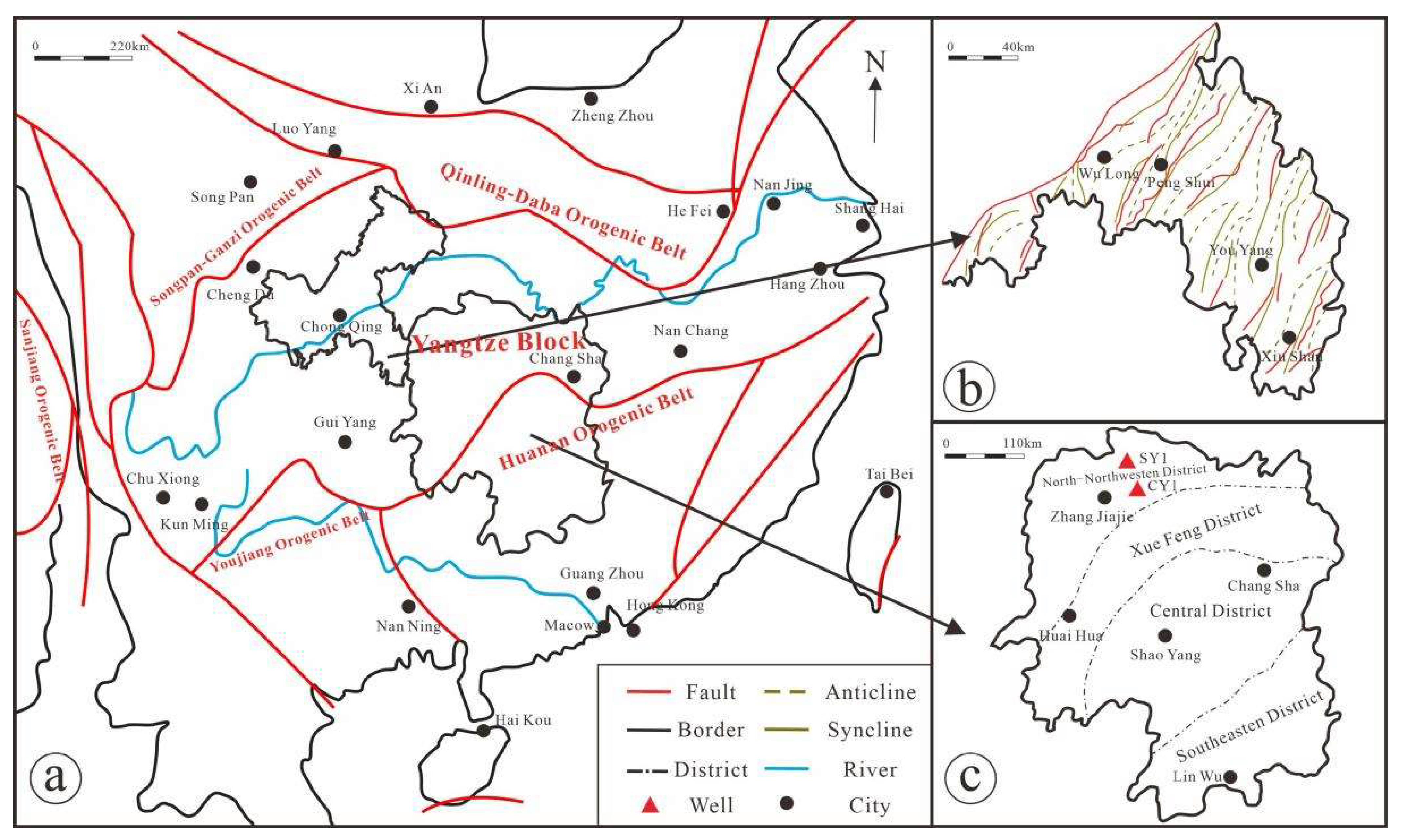
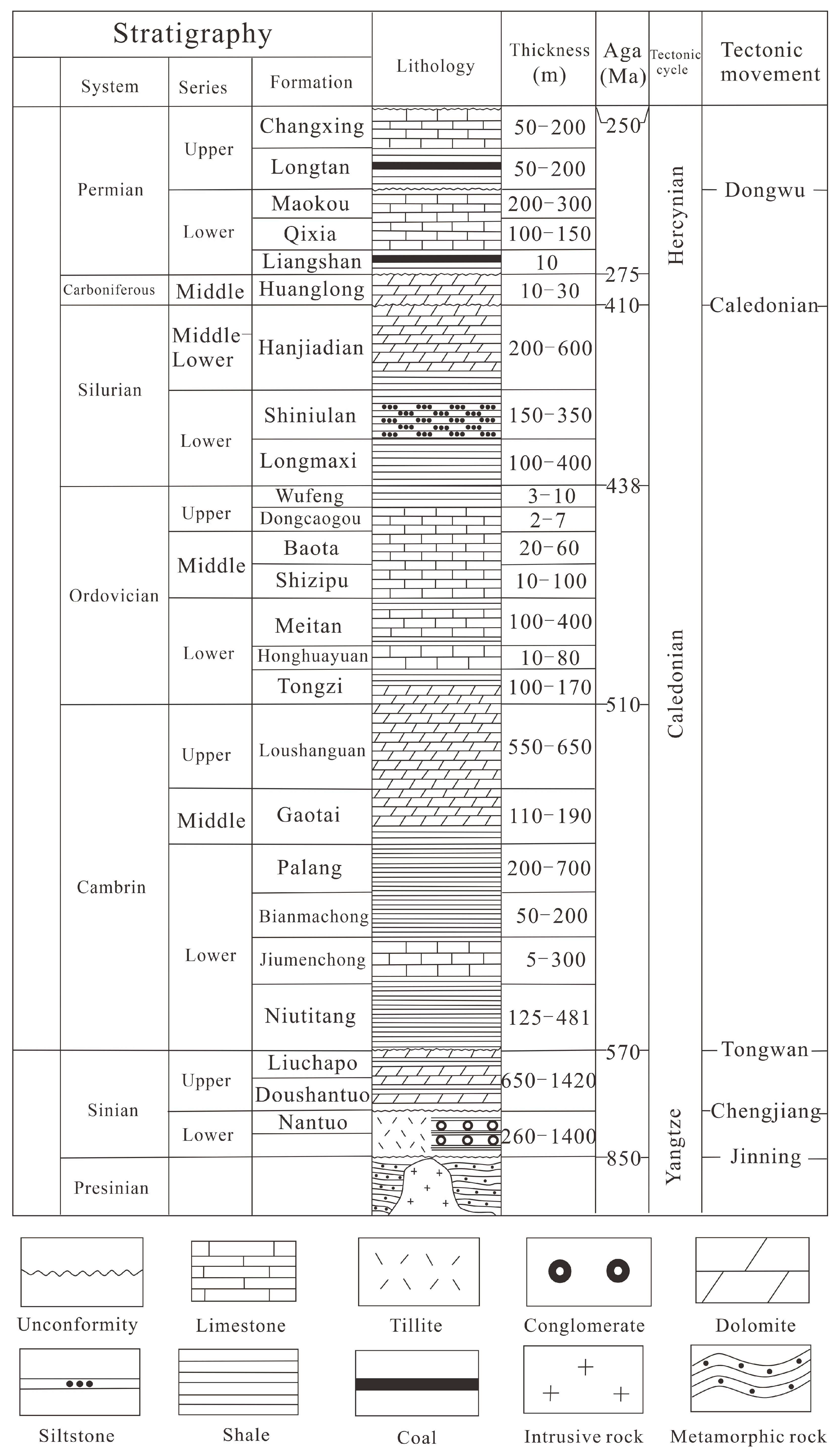
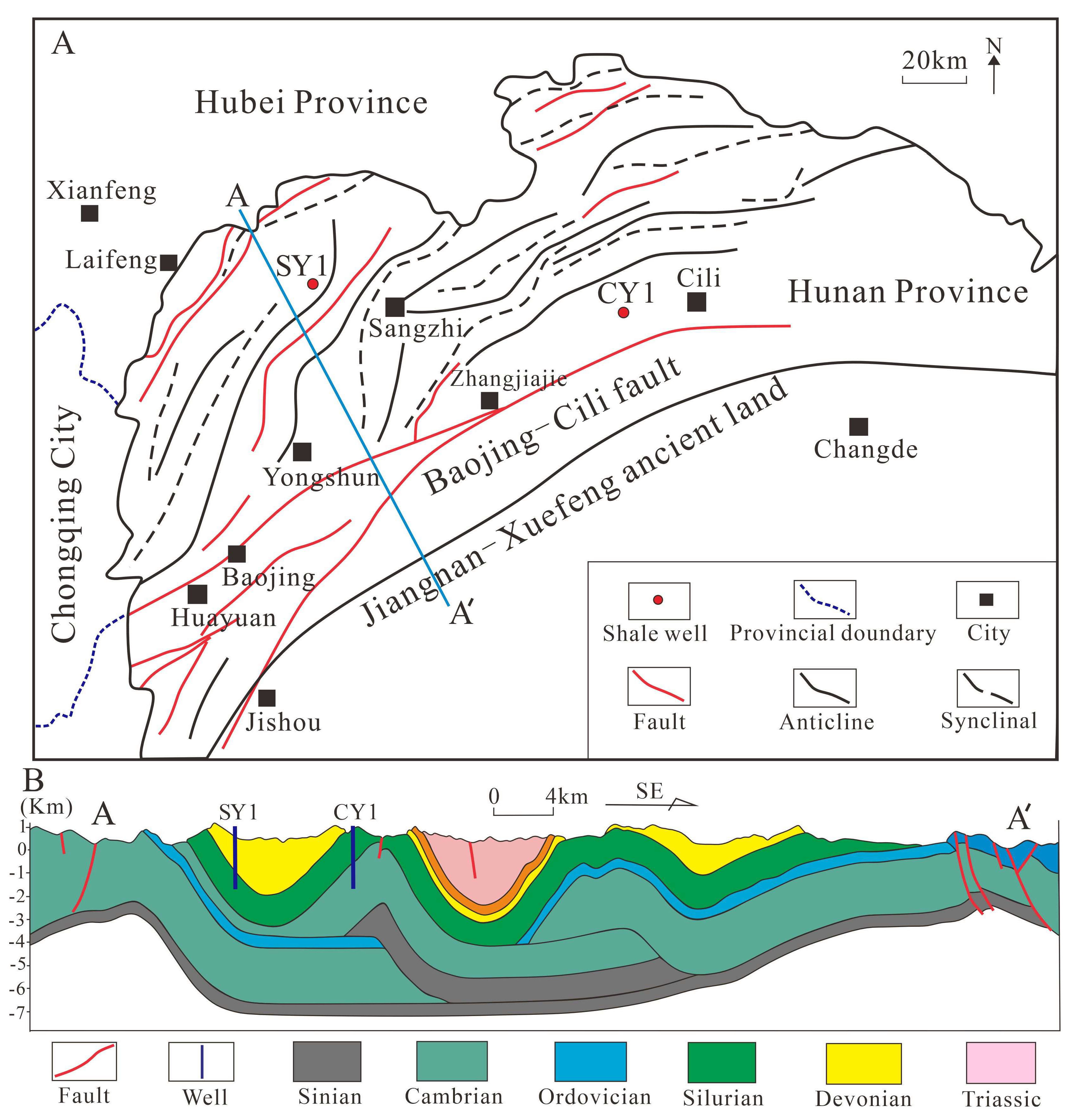


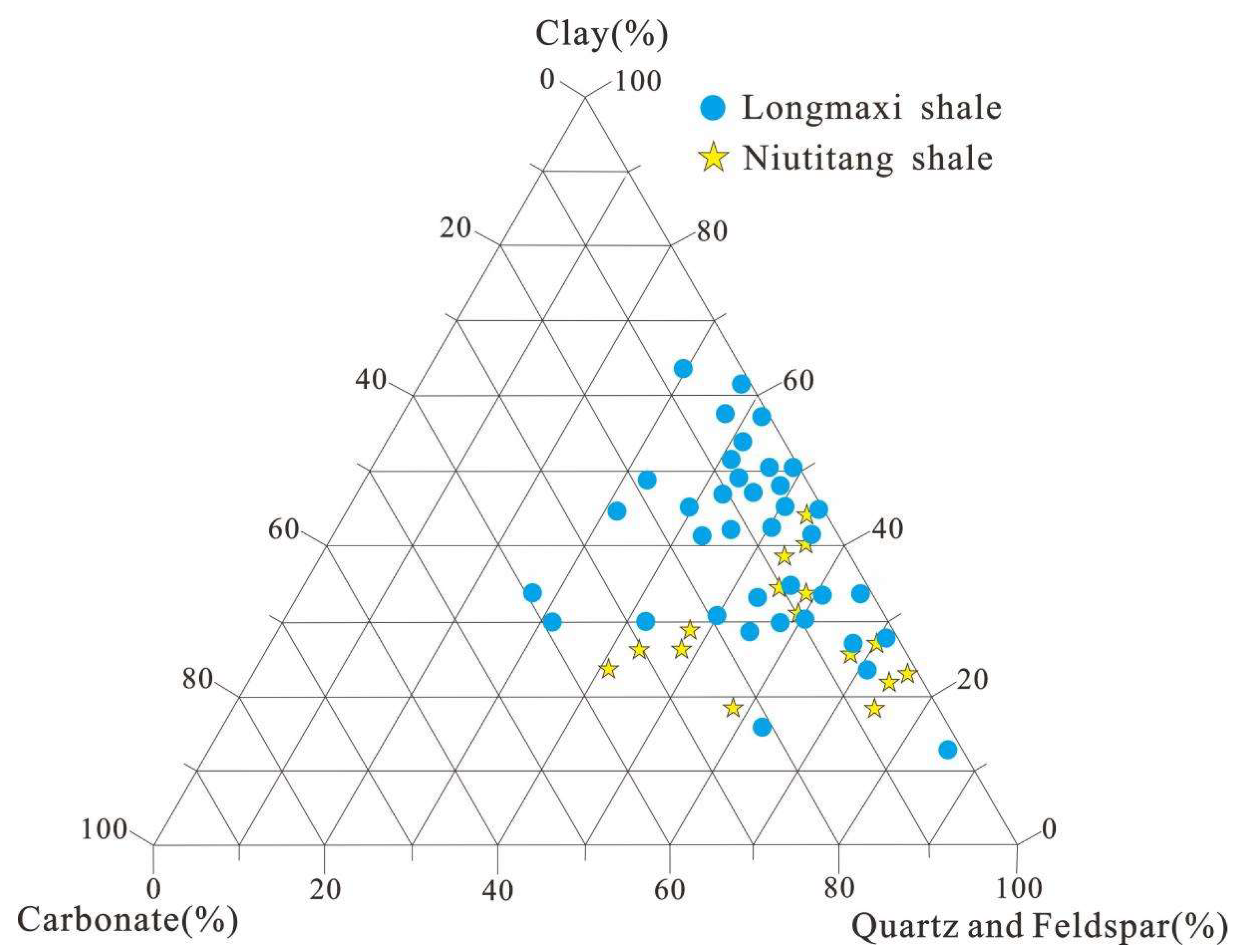
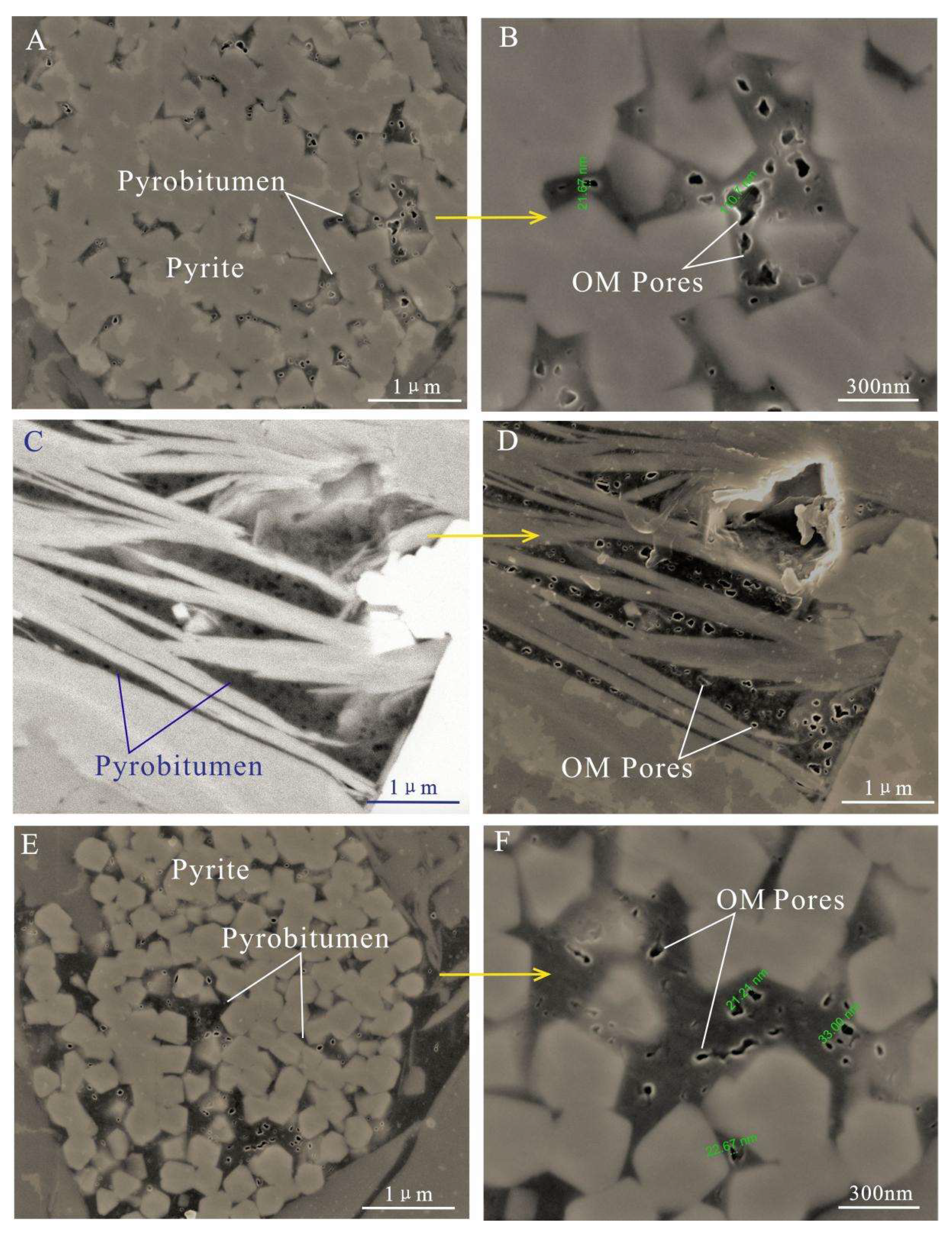
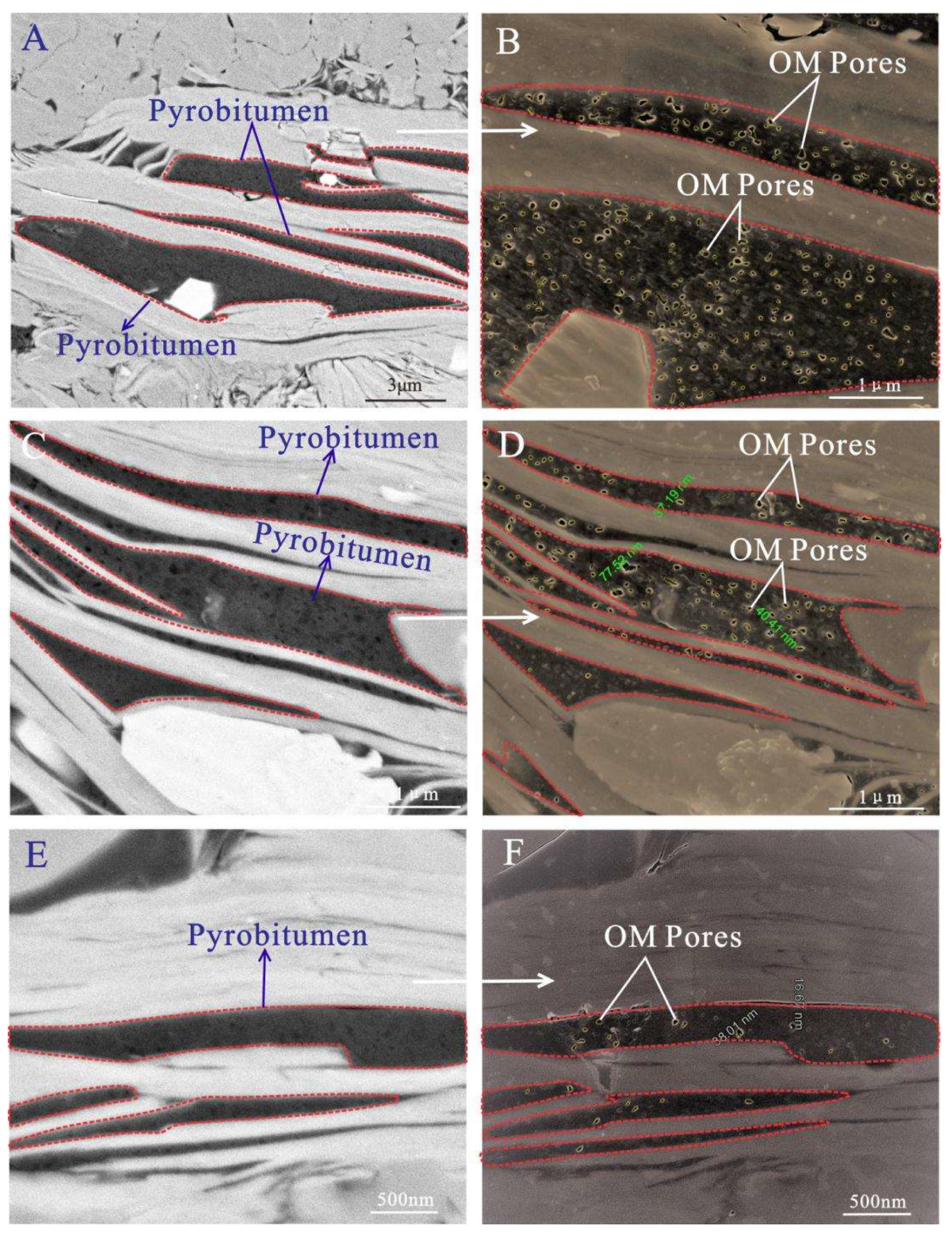
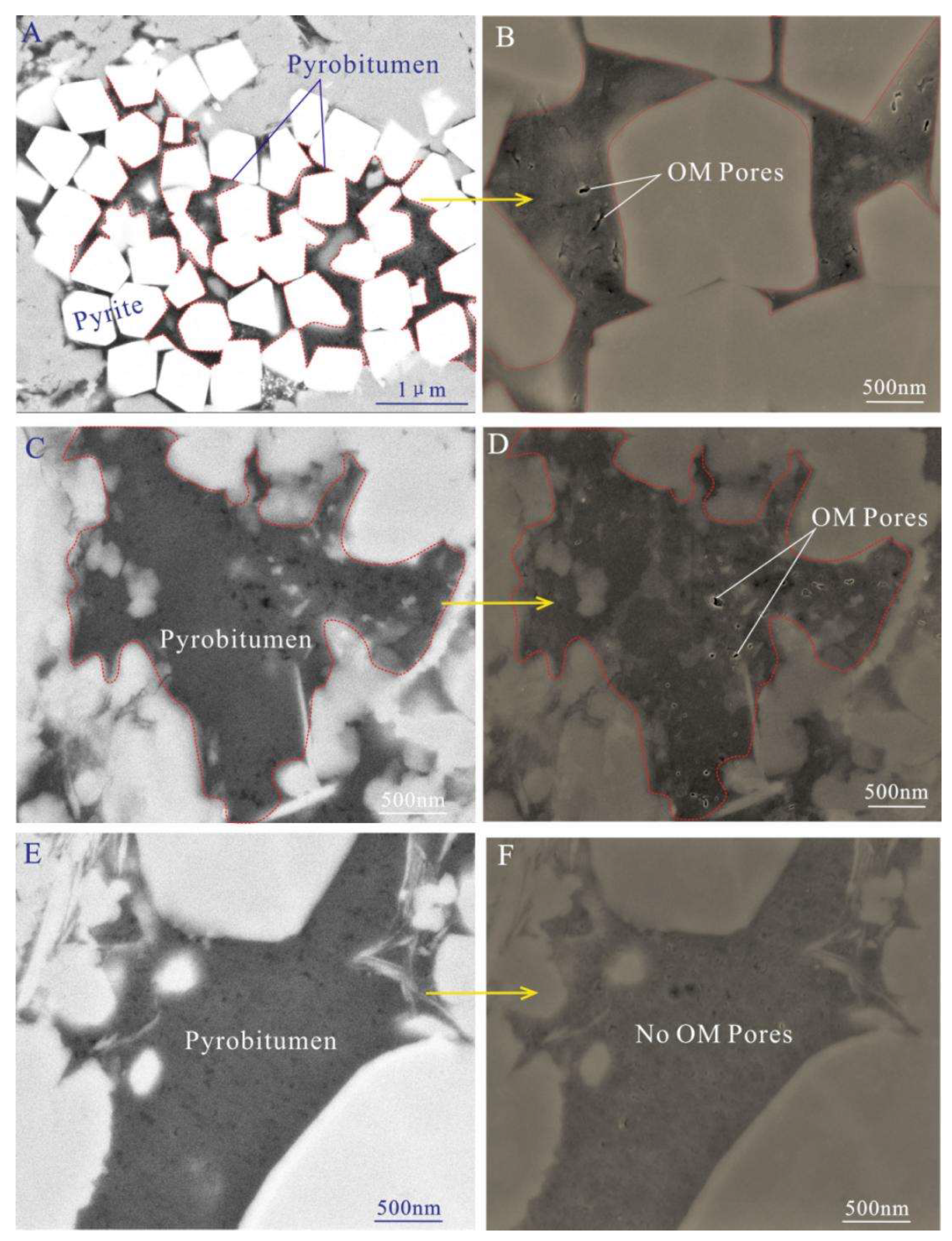
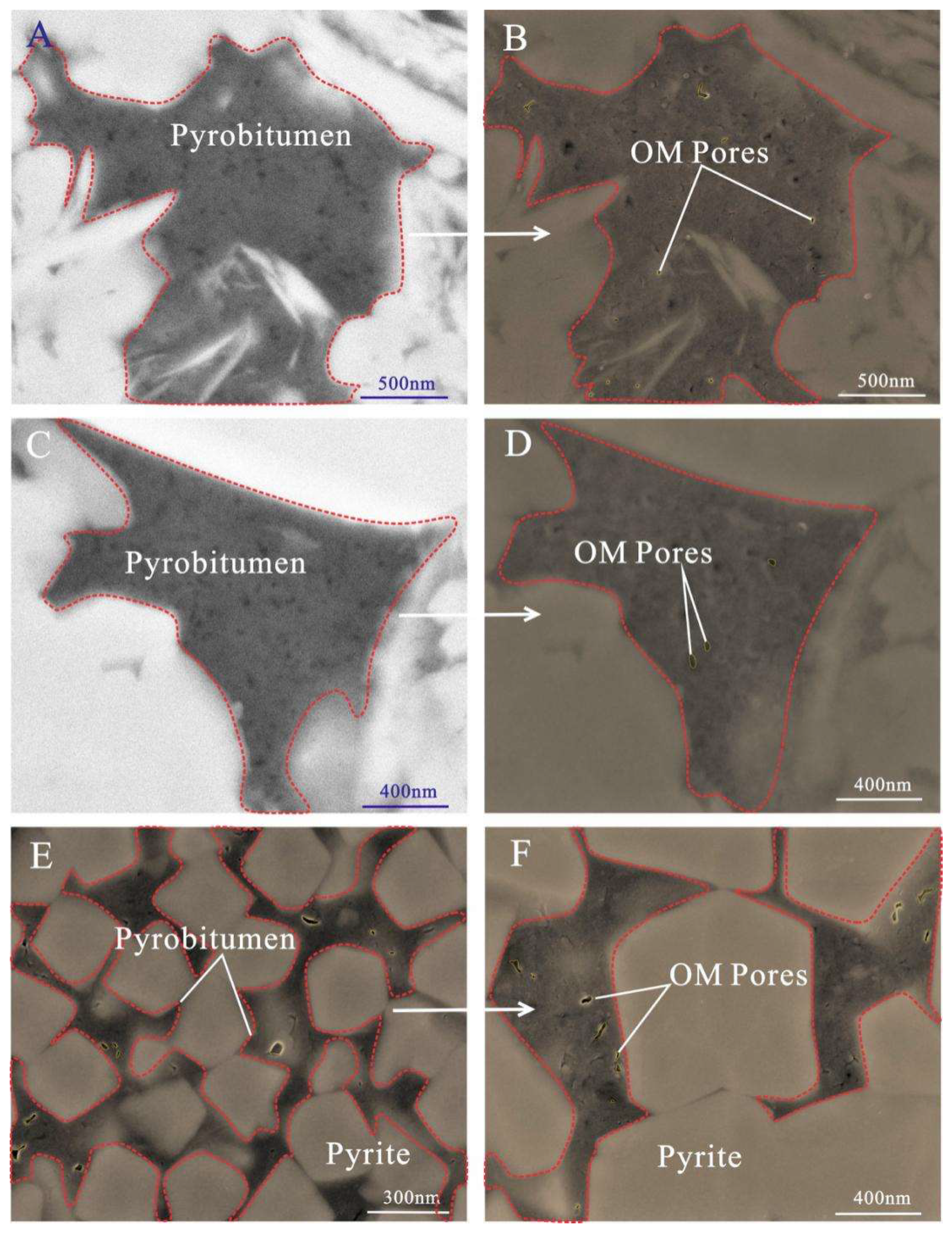


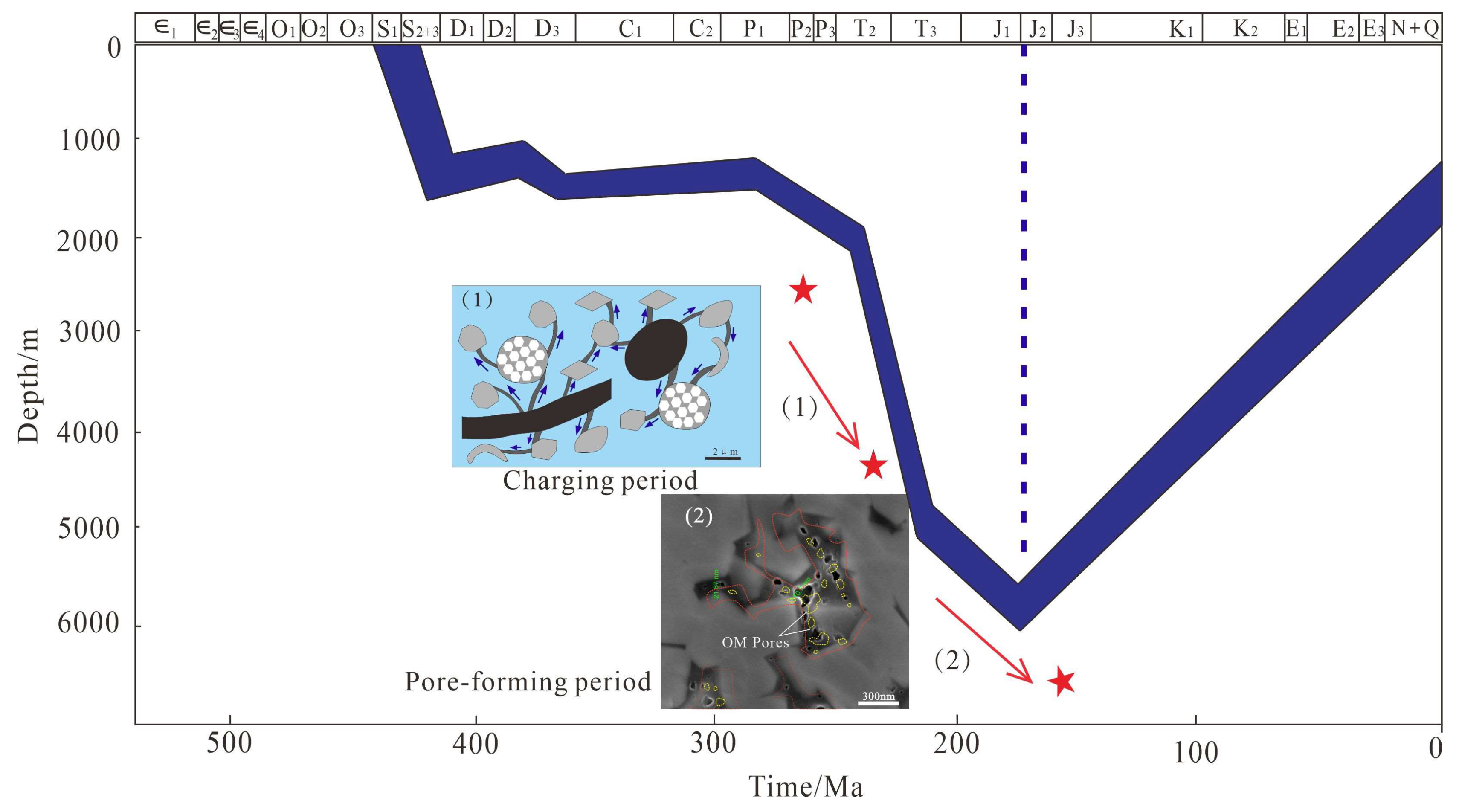

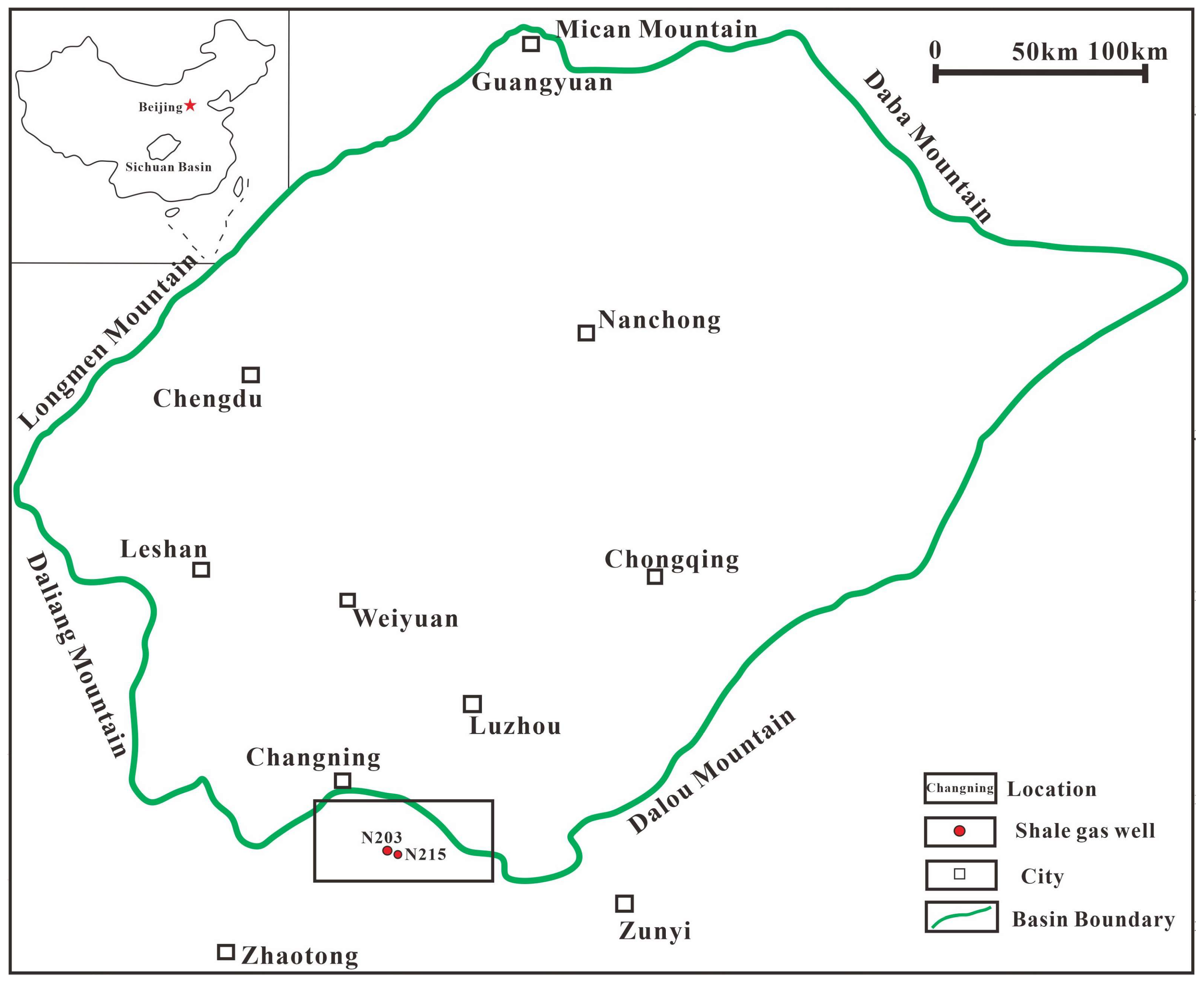

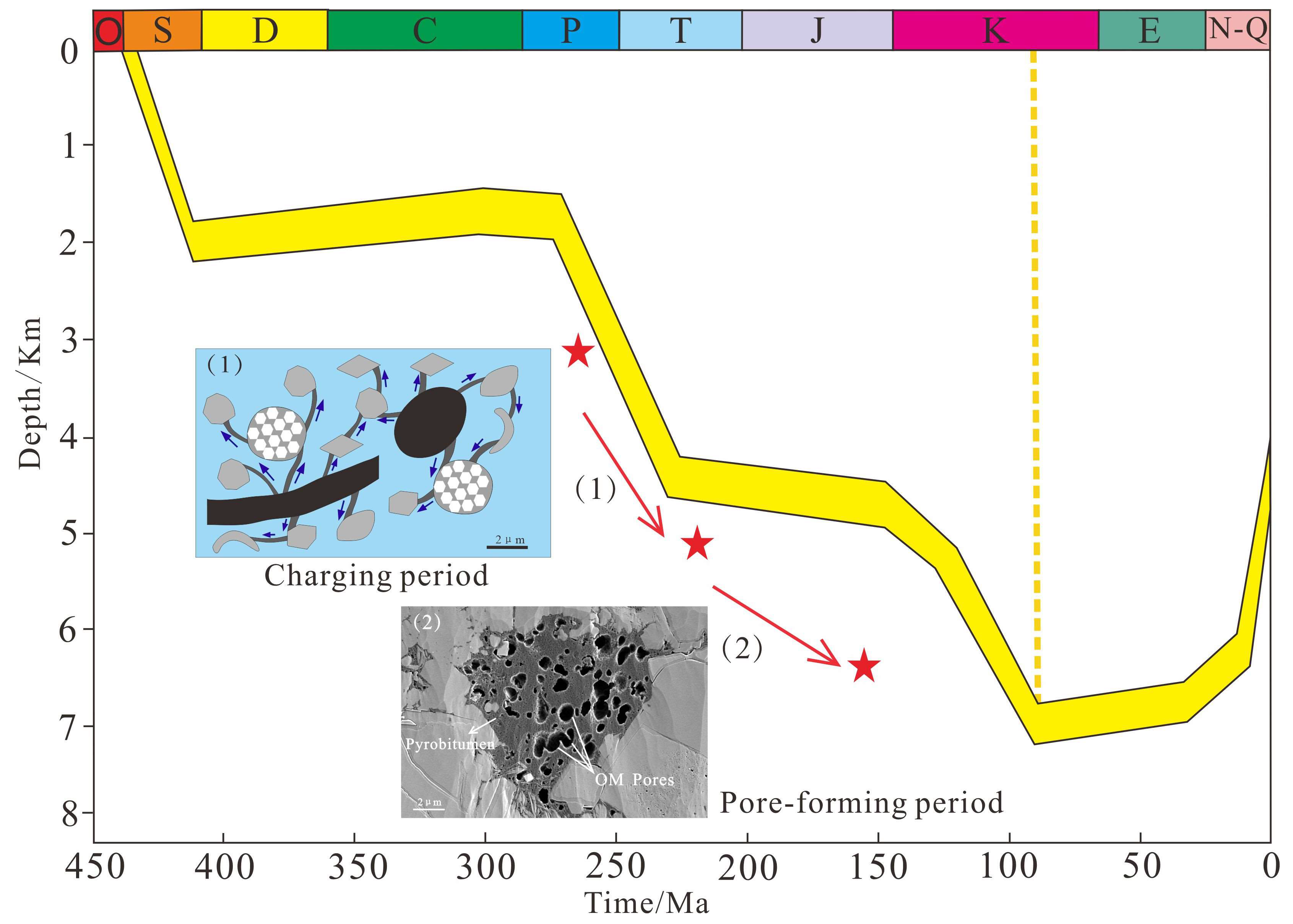

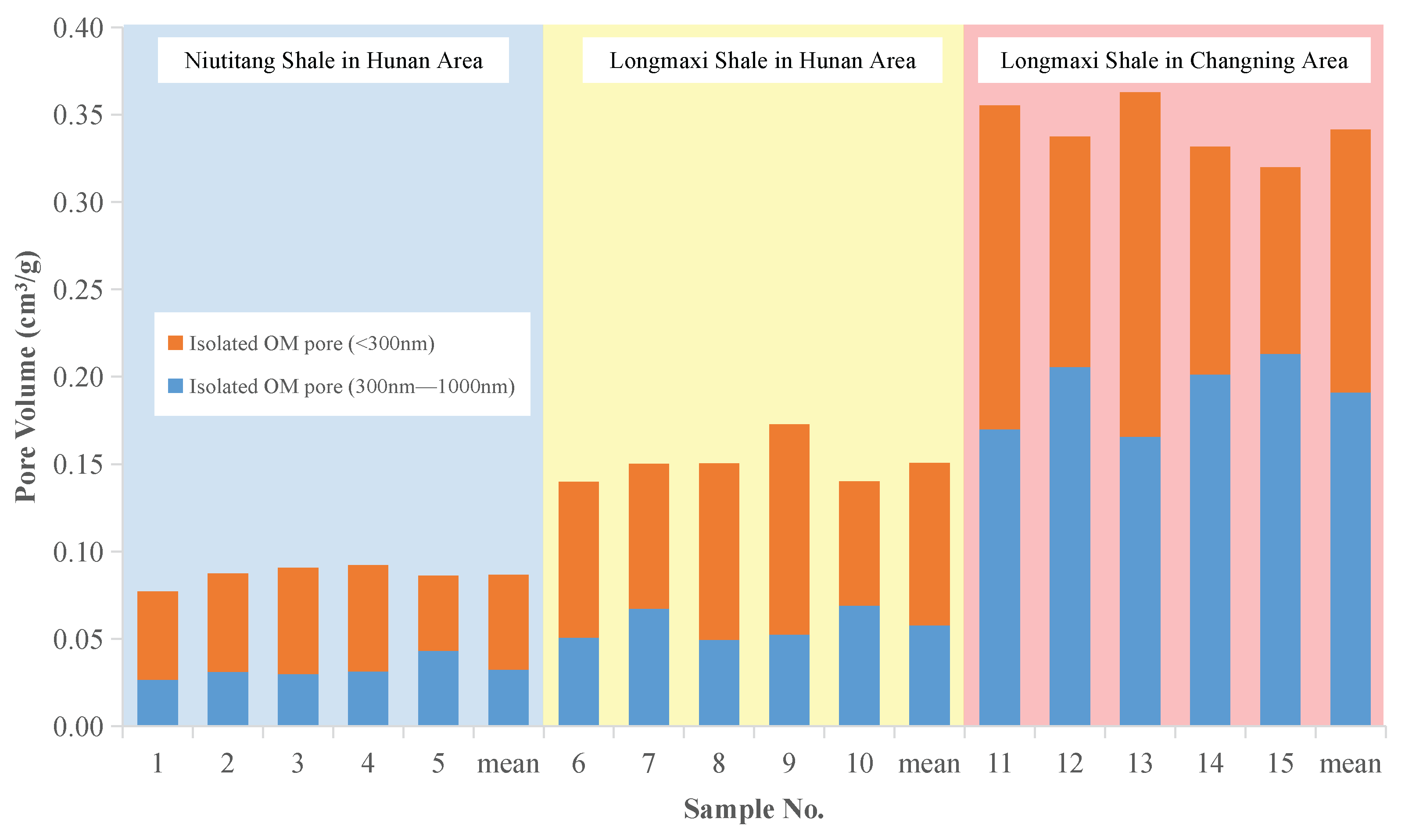
| Formation | Depth (m) | Average TOC (%) | Average Ro (%) | Average Gas Content (m3/t) | Straight well Gas Production (104 m3/d) | Porosity (%) |
|---|---|---|---|---|---|---|
| Longmaxi | 1024–1083 | 2.5 | 2.68 | 1.5 | 2.0 | 1.50 |
| Niutitang | 2600–2749 | 4.83 | 3.28 | 0.86 | 0.3 | 1.66 |
| Sample | Formation | Depth (m) | TOC (%) | Ro (%) | Solid Kerogen | Mineral (%) | ||||
|---|---|---|---|---|---|---|---|---|---|---|
| Quartz | Feldspar | Clay | Carbonate | Pyrite | ||||||
| #1 | Longmaxi | 1569.2 | 2.08 | 2.56 | Ⅰ | 54.3 | 7.4 | 31.2 | 2.7 | 3.3 |
| #2 | Niutitang | 2712.4 | 4.12 | 3.42 | Ⅰ | 52.1 | 5.6 | 27.3 | 8.7 | 4.1 |
Disclaimer/Publisher’s Note: The statements, opinions and data contained in all publications are solely those of the individual author(s) and contributor(s) and not of MDPI and/or the editor(s). MDPI and/or the editor(s) disclaim responsibility for any injury to people or property resulting from any ideas, methods, instructions or products referred to in the content. |
© 2023 by the authors. Licensee MDPI, Basel, Switzerland. This article is an open access article distributed under the terms and conditions of the Creative Commons Attribution (CC BY) license (https://creativecommons.org/licenses/by/4.0/).
Share and Cite
Miao, Y.; Wang, P.; Li, X.; Huang, H.; Jin, C.; Gao, W. Shale Gas Exploration and Development Potential Analysis of Lower Cambrian Niutitang Formation and Lower Silurian Longmaxi Formation in Northwestern Hunan, South China, Based on Organic Matter Pore Evolution Characteristics. J. Mar. Sci. Eng. 2023, 11, 1910. https://doi.org/10.3390/jmse11101910
Miao Y, Wang P, Li X, Huang H, Jin C, Gao W. Shale Gas Exploration and Development Potential Analysis of Lower Cambrian Niutitang Formation and Lower Silurian Longmaxi Formation in Northwestern Hunan, South China, Based on Organic Matter Pore Evolution Characteristics. Journal of Marine Science and Engineering. 2023; 11(10):1910. https://doi.org/10.3390/jmse11101910
Chicago/Turabian StyleMiao, Yanan, Pengfei Wang, Xin Li, Haiping Huang, Can Jin, and Wei Gao. 2023. "Shale Gas Exploration and Development Potential Analysis of Lower Cambrian Niutitang Formation and Lower Silurian Longmaxi Formation in Northwestern Hunan, South China, Based on Organic Matter Pore Evolution Characteristics" Journal of Marine Science and Engineering 11, no. 10: 1910. https://doi.org/10.3390/jmse11101910




